For years seen as the perfect solution for easing people into the upcoming electric car future, plug-in hybrid (PHEV) cars are not used as they should. That results in extraordinary differences in fuel economy and emissions between real-life driving and laboratory tests.
According to German researchers, PHEVs use more fossil fuels and emit up to four times more carbon dioxide in the real world, and it all comes down to drivers not using the cars’ electric motors as much as they should.
A team of researchers from the Fraunhofer Institute for Systems and Innovation Research analyzed data on the real-world fuel economy and distance traveled annually of more than 100,000 PHEVs driven in the U.S., Canada, China, Germany, the Netherlands, and Norway.
The team found that the carbon dioxide emissions of plug-in hybrids averaged between 50 and 300 grams of CO2 per km, which is up to four times higher than the emissions seen in laboratory test cycles—both WLTP and NEDC, its European predecessor.
Apparently, the official assumptions regarding distance driven on a daily basis and battery charging using external sources was overly optimistic, with most drivers almost never charging their cars from an electrical outlet and depleting their batteries a lot sooner.
As you know, plug-in hybrid vehicles (PHEVs) usually combine an internal combustion engine (ICE) with at least one electric motor, which sources its power from an onboard battery that can be charged either during driving or via an external charging outlet.
In theory, they should be the best of both worlds, using much less fuel than a regular ICE-powered car and having a much longer range than a fully electric car.
Researchers say that because most PHEV drivers almost never charge their cars during their daily routine, most of the time, they run in either hybrid or even full ICE mode, rendering them a lot more inefficient than they could be.
The study’s conclusion was not against the proliferation of PHEVs but for introducing better ways of encouraging drivers of such cars to charge them from external sources more, thus fully benefitting from their intended purpose.
A team of researchers from the Fraunhofer Institute for Systems and Innovation Research analyzed data on the real-world fuel economy and distance traveled annually of more than 100,000 PHEVs driven in the U.S., Canada, China, Germany, the Netherlands, and Norway.
The team found that the carbon dioxide emissions of plug-in hybrids averaged between 50 and 300 grams of CO2 per km, which is up to four times higher than the emissions seen in laboratory test cycles—both WLTP and NEDC, its European predecessor.
Apparently, the official assumptions regarding distance driven on a daily basis and battery charging using external sources was overly optimistic, with most drivers almost never charging their cars from an electrical outlet and depleting their batteries a lot sooner.
As you know, plug-in hybrid vehicles (PHEVs) usually combine an internal combustion engine (ICE) with at least one electric motor, which sources its power from an onboard battery that can be charged either during driving or via an external charging outlet.
In theory, they should be the best of both worlds, using much less fuel than a regular ICE-powered car and having a much longer range than a fully electric car.
Researchers say that because most PHEV drivers almost never charge their cars during their daily routine, most of the time, they run in either hybrid or even full ICE mode, rendering them a lot more inefficient than they could be.
The study’s conclusion was not against the proliferation of PHEVs but for introducing better ways of encouraging drivers of such cars to charge them from external sources more, thus fully benefitting from their intended purpose.

